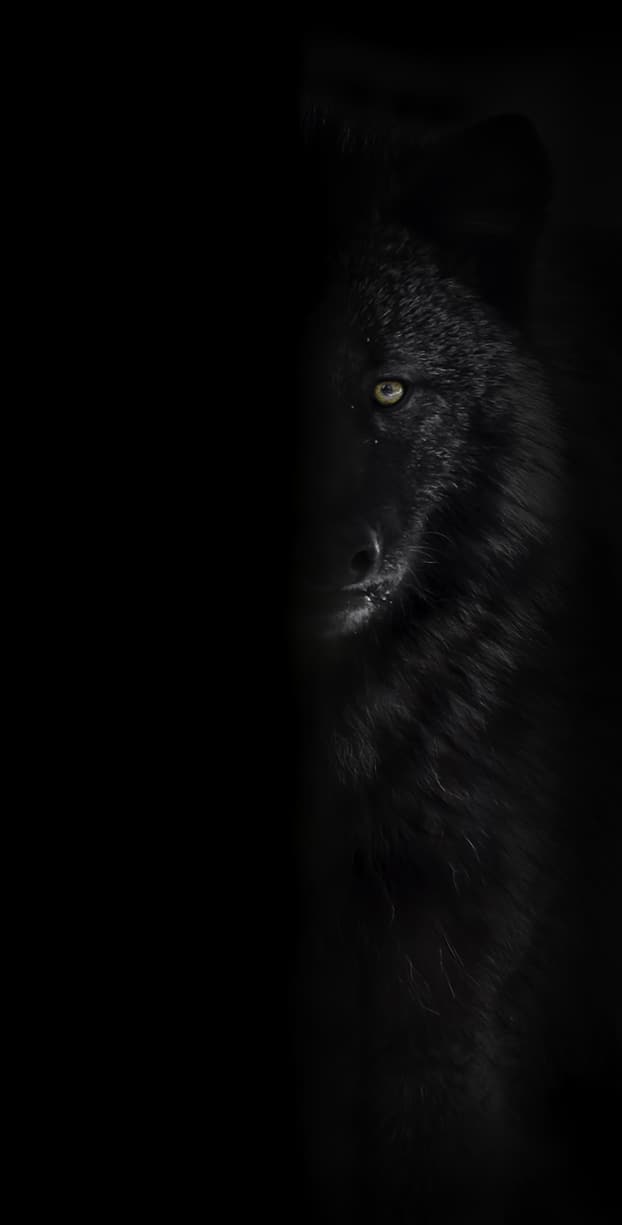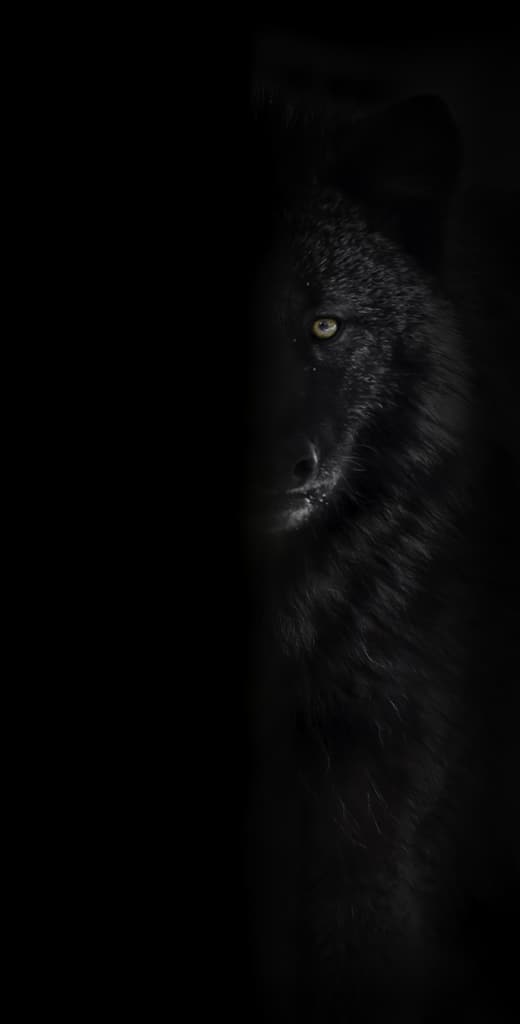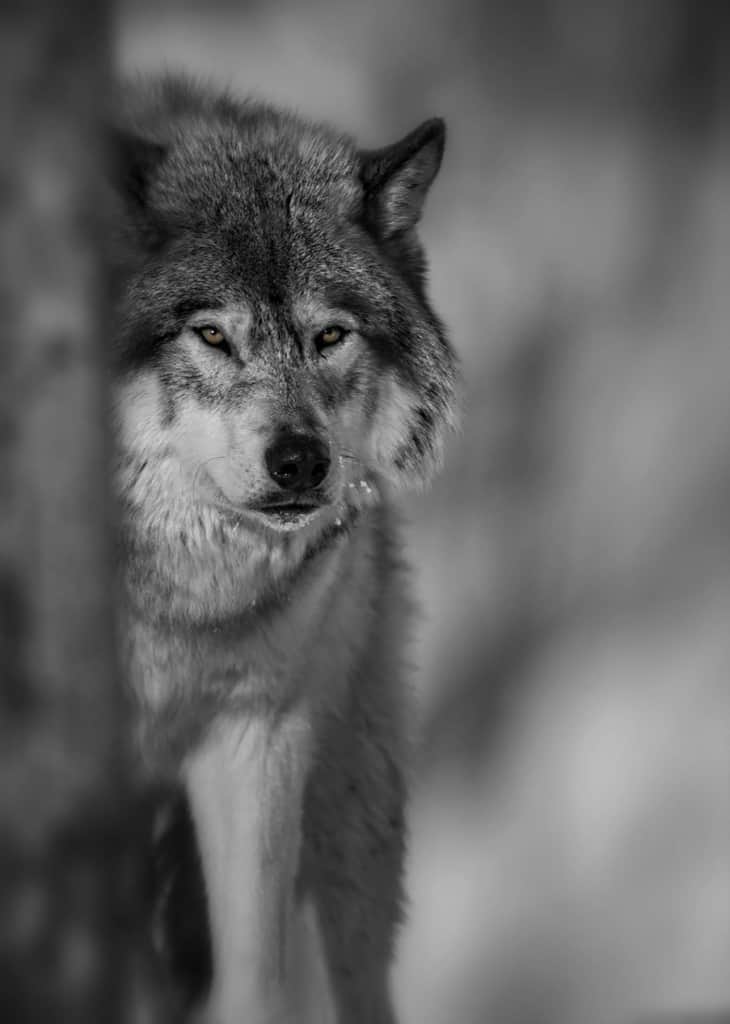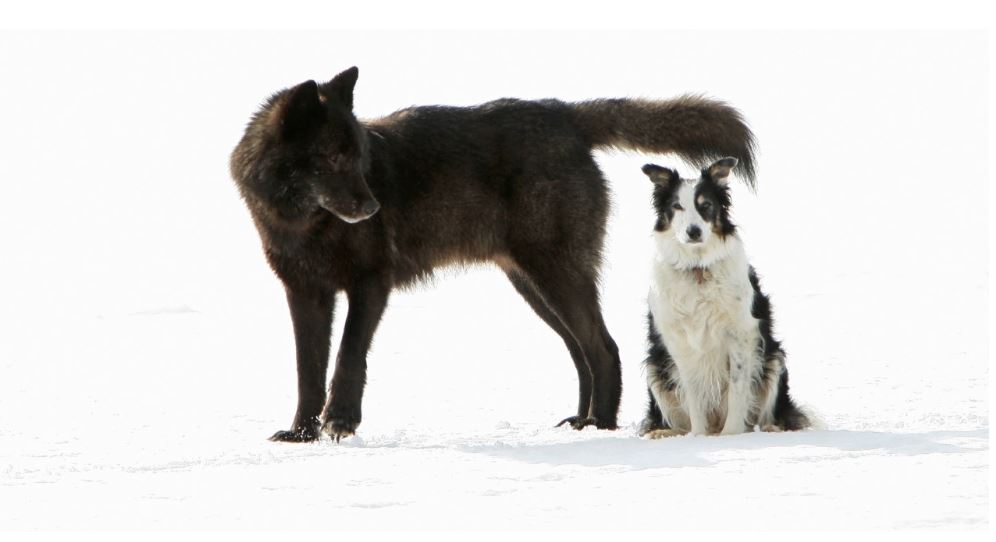The mere mention of Black Wolf fills many of us with fear and others with questions. By the time you’re done reading this article I hope to have dispelled the myths and answered your questions. WARNING: If you wish to keep your fear and mystery surrounding the Black Wolf alive STOP reading now.
The “Black Wolf Behind Tree Image” above is available for sale in fine art print, canvas, metal and acrylic,
Let’s get right to the point and answer the most commonly asked question.
What is a Black Wolf?
Turns out the Black Wolf is a wolf in dog’s clothing. Dr. Gregory Barsh from Stanford University and his team discovered that the fur of a black wolf comes from the genetic makeup of the domestic dog. In North America, black wolves have inherited the allele responsible for melanism, which comes from the crossbreeding of dark coloured domestic dogs and grey wolves. Barsh’s team places the origin of this crossbreeding some 3,000 to 120,000 years ago.
Black Wolf Factoid
North America has more black wolves than anywhere else in the world thus it is thought that the inter-breeding may have originated in North America. Half of the wolves in Yellowstone National Park are black wolves.
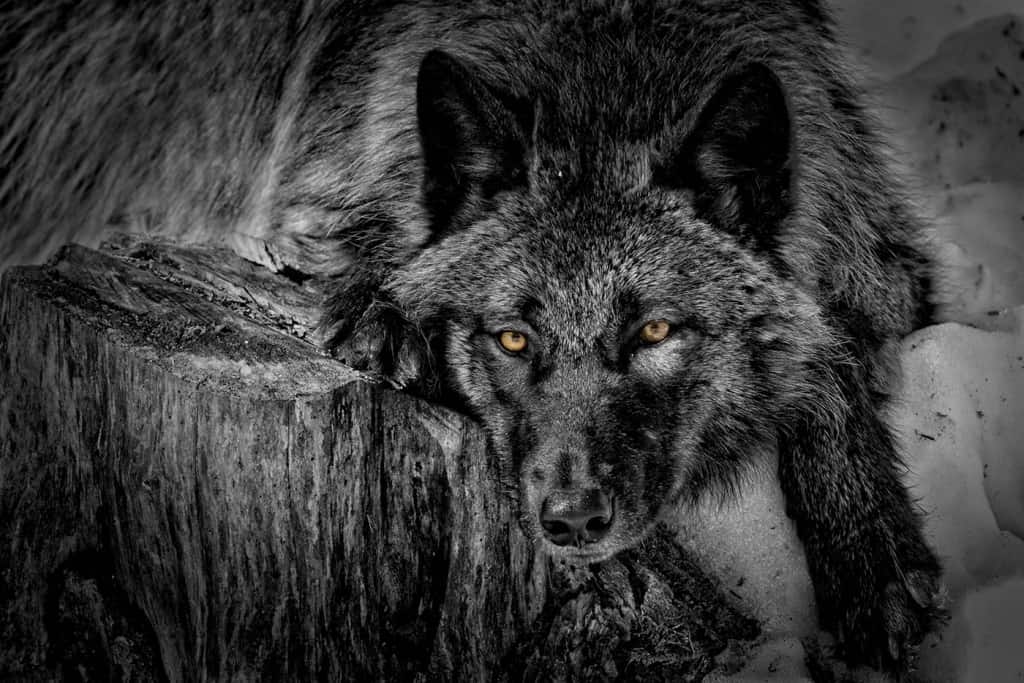
UNRAVELLING THE MYSTERY
You already know that each of today’s domestic dog breeds originated from the grey wolf. What you may not have known is that the black wolf may exist today as a result of humans having a favor towards breeding dogs that were darker in color. When these darker colored domestic dogs bred with wild grey wolves some 40,000 years ago the darker melanism was passed along through wolf populations.
The Chicken Or The Egg
I chose the word “may have” above very carefully. Since dogs were domesticated 40,000 years ago and Dr. Barsh’s research estimates that the dark colored mutation in wolves arose between 13,000 and 120,00 years ago the possibility exists that the dark colored mutation first arose in wolves and was passed along to domestic dogs through inter-breeding.
Turns out the mystery of the black wolf isn’t quite unravelled yet, but researchers are continuing to piece together this puzzle to bring forward answers. As you can see from the image above, not all variants of the black wolf are jet black. For those of you who love wolves I think you’ll love spending time viewing the images on my Wolf Gallery once you’re done reading this article. I have posted the link again at the bottom of this article for your convenience. You’ll need to click on the category for wolves to view only the wolf images.
More Scientific Observations
As black-colored wolves occur more frequently in forested areas than on the tundra (black coats occur in about 62% of wolves in the forested areas of the Canadian Arctic, compared with about 7% in the icy tundra, melanism was concluded by the researchers to give those wolves an adaptive advantage. The mutation’s purpose has not yet been identified. Dr. Barsh ruled out camouflage, as wolves have few natural predators, and there is no evidence that a black coat color leads to any increase in hunting success rates.
Dr. Barsh observed that beta-defensin is involved in providing immunity to viral and bacterial skin infections which might be more common in forested, warmer environments. It has been suggested that the mutation’s association with forested habitats means that the prevalence of melanism should increase as forests expand northward. Dark fur is believed to be dominant in wolves. A mating between a black and a grey wolf resulted in 10 pups with dark fur out of a total of 14. For those of you who want to take this to the next level and really go deep on Black Wolf Research I’d suggest you start with Wikipedia which provides copious detail and additional articles for reference.
Black Wolf Factoid
Black wolves usually grow to somewhere between 60 and 140 pounds, with males being bigger than females. The largest wolf ever recorded was a black wolf living in Yellowstone National Park that weighed in at 143 pounds.
THE FEAR FACTOR
Time for a question that only you can answer. You find yourself out on a photo shoot and you stayed a little longer than you had anticipated. As you walk along the trail on your way out to your car you get the feeling that you’re being watched. Which of these images stirs up more fear in you, the black wolf or the grey wolf? Some of you may have answered both but statistically speaking most of you would have selected the image of the black wolf. Think about it for a moment, why do you think that is?
A 2013 study by Penn State psychologists revealed that people find images of black dogs scarier than photos of yellow or brown dogs—respondents rated the dark-furred animals less adoptable, less friendly, and more intimidating. This same pattern of thinking carries over to wolves and as such most of us respond with more fear being elicited from the black wolf image. But is there really anything to be afraid of when it comes to wolves regardless of colour?
WOLF AGGRESSION VS ATTACKS
Movies like The Grey with Liam Neeson portray wolves as dangerous man eaters that track down man in the wild for their next meal. This sensationalism is not representative of the real world. Wolves generally work hard to avoid humans. That being said there are a few situations where wolves will tend to be more aggressive.
These more assertive behaviors are almost always related to denning/rendezvous sites and typically occur from April through July. This is the time when wolves are raising their pups. If you happen upon one of these sites you may be subject to displays that are designed to intimidate and scare you off. Even in this scenario these displays are not attacks. Wolves are very social and territorial and do not want to move from their pups from established denning areas or rendezvous sites.
To present another point of view the United States Fish and Wildlife Service concludes that wolves are very shy of humans but are opportunistic hunters and will attack humans if the opportunity arises and advise against “actions that encourage wolves to spend time near people”. I think the take away here is to be aware of your surroundings and respectful such to avoid such situations that pose a higher risk. But many ask the question regarding Black Wolves and aggression.
Are Black Wolves More Aggressive?
Charles Hamilton Smith Charles Hamilton Smith, artist and naturalist wrote that black wolves were generally less aggressive than ordinary kinds, and interbred with dogs more readily. Clearly a study of one is not significant enough to draw a conclusion however it does suggest that our fears regarding Black Wolves may be unwarranted.
Black Wolf Factoid
Black Wolves will run at a speed of 40 miles per hour and have very few predators in the wild.
A HEART WARMING BLACK WOLF STORY
Soon Romeo, as the wolf came to be known, captured the hearts of almost the entire town. But its presence raised complex questions. Should a predatory animal, however friendly, be encouraged to live among people and their children? What if someone decided to shoot it?
Talking from his winter home in Florida, Nick Jans, a former hunter turned wildlife photographer and the author of A Wolf Called Romeo, describes how some tracks in the snow led to an encounter that would change his life; why the Inuit revere the wolf; and why there are parts of the book he still can’t read in public without crying. You can read more about Romeo the Black Wolf and this incredible story through this link.
THE THINGS THAT DREAMS ARE MADE OF
Moving away from science and into the realm just plain fun. Many folks have questions around their dreams and there meanings.
What does it mean if I see a black wolf in my dreams?
According to those in the know, a black wolf in your dream represents an individual who is either in your life now or will come to be in the future and they are going to bring you a lot of troubles and problems. If only we knew who that person was we could avoid them.
As mentioned above if you have a love of wolves be sure to visit the Coolwildlife Wolf Gallery. You’ll need to click on the category for wolves to view only the wolf images.



